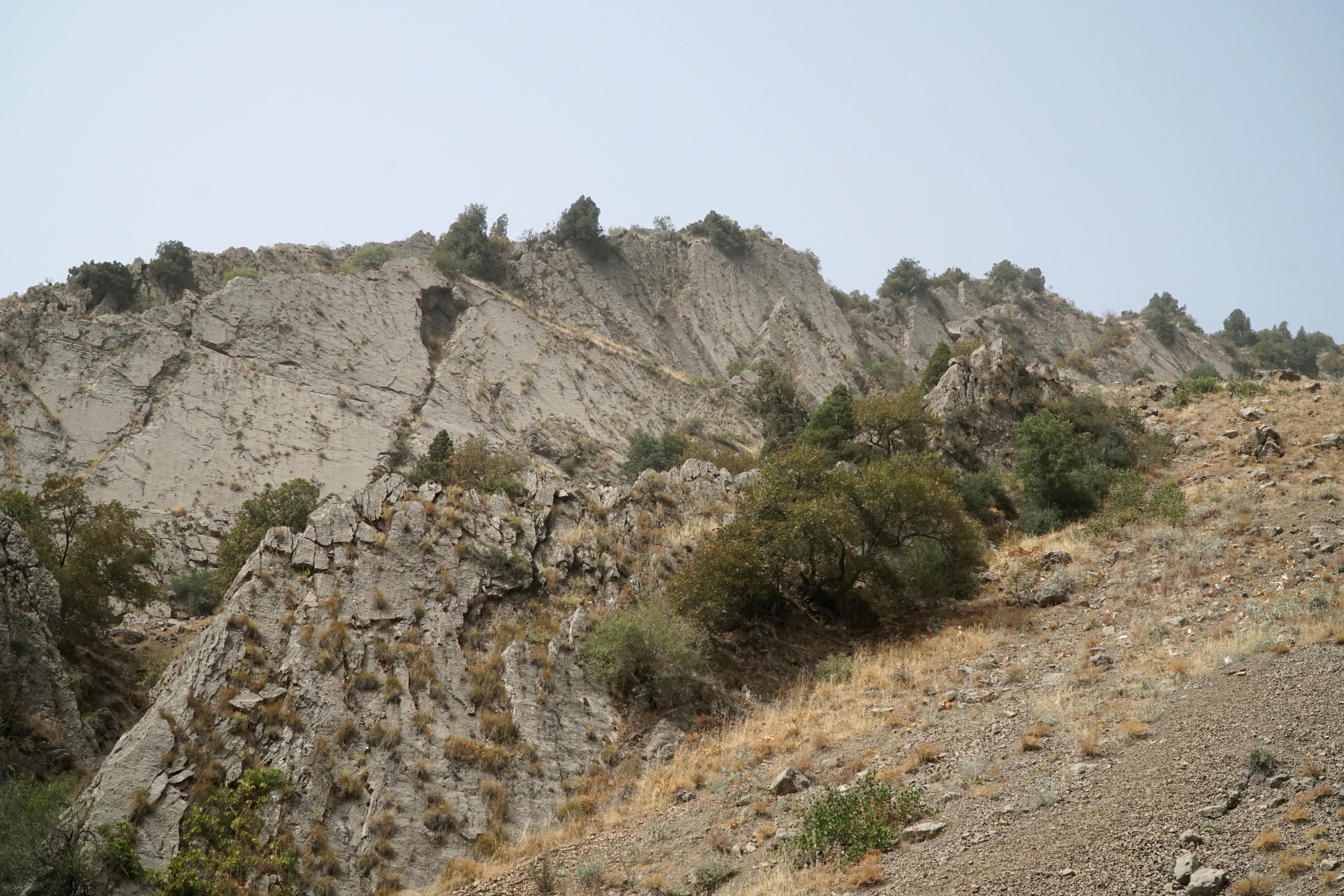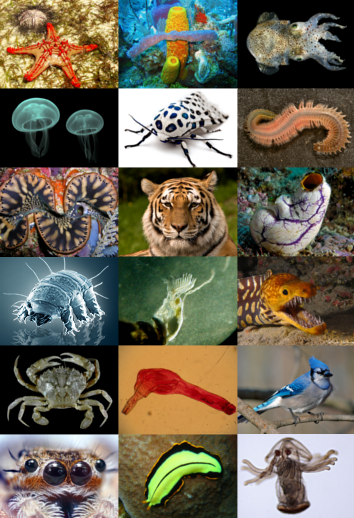|
Macropodosaurus
''Macropodosaurus'' is an ichnogenus of therizinosaurid footprints from the Late Cretaceous of Asia, North America and Poland. The ichnogenus is currently monotypic only including the type ichnospecies ''M. gravis'', described and named in 1964. When first described, ''Macropodosaurus'' tracks were inferred to have been made by a bipedal, yet indeterminate type of dinosaur. In 2006 it was re-evaluated and concluded to represent footprints of therizinosaurid dinosaurs based on comparisons with skeletal feet remains. History of discovery In 1963, Russian geologist F.H. Khakimov discovered unusual bipedal trackways at the Shirkent-1 locality of the Shirabad Formation in the Shirkent River valley (Tajikistan). The material consisted of a series of four-toed footprints found in Cenomanian slabs of hard clayey limestone. They later became the holotype material for the new ichnogenus and ichnospecies ''Macropodosaurus gravis'', described and named in 1964 by Sergey A. Zakharov. He ... [...More Info...] [...Related Items...] OR: [Wikipedia] [Google] [Baidu] |
Therizinosaurid
Therizinosauridae (meaning 'scythe lizards')Translated paper is a family of derived (advanced) therizinosauroid whose fossil remains have been found in mostly Late Cretaceous boundary. Even though representative fossils have only been found throughout Asia and , the range of Therizinosauridae is believed to ... [...More Info...] [...Related Items...] OR: [Wikipedia] [Google] [Baidu] |
Timeline Of Therizinosaur Research
The timeline of therizinosaur research is a chronological listing of events in the history of paleontology focused on therizinosaurs. They were unusually long-necked, pot-bellied, and large-clawed herbivorous theropods most closely related to birds. The early history of therizinosaur research occurred in three phases. The first phase was the discovery of scanty and puzzling fossils in Asia by the Central Asiatic Expeditions of the 1920s and Soviet-backed research in the 1950s. This phase resulted in the discovery of the ''Therizinosaurus cheloniformis'' type specimen. Soviet paleontologist Evgeny Maleev interpreted these unusual remains as belonging to some kind of gigantic turtle. The second major phase of therizinosaur research followed the discovery of better preserved remains in the 1970s by collaborative research between the Soviets and Mongolians. These finds revealed the true nature of therizinosaurs as bizarre dinosaurs. However, the exact nature and classification of ther ... [...More Info...] [...Related Items...] OR: [Wikipedia] [Google] [Baidu] |
List Of Dinosaur Ichnogenera
This list of dinosaur ichnogenera is a comprehensive listing of all ichnogenera that have been attributed to dinosaurs, excluding class Aves (birds, both living and those known only from fossils) and purely vernacular terms. The list includes all commonly accepted ichnogenera, but also genera that are now considered invalid, doubtful (''nomen dubium''), or were not formally published (''nomen nudum''), as well as junior synonyms of more established names, and ichnogenera that are no longer attributed to dinosaurs. Scope and terminology There is no official, canonical list of dinosaur ichnogenera. An extensive list can be found in an appendix to Donald F. Glut's third supplement to his series of dinosaur encyclopedias (2003). The vast majority of citations are based on Glut's list; exceptions, such as more recent ichnotaxa, are noted. Synonymies are also after Glut. A B C D E F G H I J K L M N O __NOTOC__ P Q R S T ... [...More Info...] [...Related Items...] OR: [Wikipedia] [Google] [Baidu] |
Late Cretaceous
The Late Cretaceous (100.5–66 Ma) is the younger of two epochs into which the Cretaceous Period is divided in the geologic time scale. Rock strata from this epoch form the Upper Cretaceous Series. The Cretaceous is named after ''creta'', the Latin word for the white limestone known as chalk. The chalk of northern France and the white cliffs of south-eastern England date from the Cretaceous Period. Climate During the Late Cretaceous, the climate was warmer than present, although throughout the period a cooling trend is evident. The tropics became restricted to equatorial regions and northern latitudes experienced markedly more seasonal climatic conditions. Geography Due to plate tectonics, the Americas were gradually moving westward, causing the Atlantic Ocean to expand. The Western Interior Seaway divided North America into eastern and western halves; Appalachia and Laramidia. India maintained a northward course towards Asia. In the Southern Hemisphere, Australia a ... [...More Info...] [...Related Items...] OR: [Wikipedia] [Google] [Baidu] |
Erlikosaurus
''Erlikosaurus'' (meaning " Erlik's lizard") is a genus of therizinosaurid that lived in Asia during the Late Cretaceous period. The fossils, a skull and some post-cranial fragments, were found in the Bayan Shireh Formation of Mongolia in 1972, dating to around 96 million and 89 million years ago. These remains were later described by Altangerel Perle and Rinchen Barsbold in 1980, naming the new genus and species ''Erlikosaurus andrewsi''. It represents the second therizinosaur taxon from this formation (alongside '' Enigmosaurus'' and '' Segnosaurus'') with the most complete skull among members of this peculiar family of dinosaurs. In contrast to most therizinosaurids, ''Erlikosaurus'' was a small member reaching nearly in length and in mass. It had a well-developed beak at the snout tip and toothed jaws that were used for its herbivorous diet. The feet ended in four toes with the first one articulated to the ankle—in contrast to the vestigial first toe of most theropods. L ... [...More Info...] [...Related Items...] OR: [Wikipedia] [Google] [Baidu] |
DeviantArt
DeviantArt (historically stylized as deviantART) is an American online art community that features artwork, videography and photography, launched on August 7, 2000 by Angelo Sotira, Scott Jarkoff, and Matthew Stephens among others. DeviantArt, Inc. is headquartered in the Hollywood area of Los Angeles, California. DeviantArt had about 36 million visitors annually by 2008. In 2010, DeviantArt users were submitting about 1.4 million favorites and about 1.5 million comments daily. In 2011, it was the thirteenth largest social network with about 3.8 million weekly visits. Several years later, in 2017, the site had more than 25 million members and more than 250 million submissions. On February 23, 2017, the company announced it was being acquired by Wix.com in a $36 million deal. History Creation DeviantArt started as a site connected with people who took computer applications and modified them to their own tastes, or who posted the applications from the original designs. As th ... [...More Info...] [...Related Items...] OR: [Wikipedia] [Google] [Baidu] |
Body Plan
A body plan, ( ), or ground plan is a set of morphological features common to many members of a phylum of animals. The vertebrates share one body plan, while invertebrates have many. This term, usually applied to animals, envisages a "blueprint" encompassing aspects such as symmetry, layers, segmentation, nerve, limb, and gut disposition. Evolutionary developmental biology seeks to explain the origins of diverse body plans. Body plans have historically been considered to have evolved in a flash in the Ediacaran biota; filling the Cambrian explosion with the results, and a more nuanced understanding of animal evolution suggests gradual development of body plans throughout the early Palaeozoic. Recent studies in animals and plants started to investigate whether evolutionary constraints on body plan structures can explain the presence of developmental constraints during embryogenesis such as the phenomenon referred to as phylotypic stage. History Among the pioneering zool ... [...More Info...] [...Related Items...] OR: [Wikipedia] [Google] [Baidu] |
Segnosaurus Restoration (plantigrade)
''Segnosaurus'' is a genus of therizinosaurid dinosaur that lived in what is now southeastern Mongolia during the Late Cretaceous, about 102–86 million years ago. Multiple incomplete but well-preserved specimens were discovered in the Gobi Desert in the 1970s, and in 1979 the genus and species ''Segnosaurus galbinensis'' were named. The generic name ''Segnosaurus'' means "slow lizard" and the specific name ''galbinensis'' refers to the Galbin region. The known material of this dinosaur includes the lower jaw, neck and tail vertebrae, the pelvis, shoulder girdle, and limb bones. Parts of the specimens have gone missing or become damaged since they were collected. ''Segnosaurus'' was a large-bodied therizinosaur that is estimated to have been about long and to have weighed about . It would have been bipedal, with the trunk of its body tilted upwards. The head was small with a beak at the tip of the jaws, and the neck was long and slender. The lower jaw was down-turned at t ... [...More Info...] [...Related Items...] OR: [Wikipedia] [Google] [Baidu] |
Dinosaur Paleobiogeography
Dinosaur paleobiogeography is the study of dinosaur geographic distribution, based on evidence in the fossil record. Late Cretaceous North America Thomas M. Lehman, in a study of Late Cretaceous dinosaur distribution, concluded that they were "remarkably provincial," with herbivorous dinosaurs exhibiting "persistent latitudinal and altitudinal zonation" in " stinctive endemic associations." Provincialism was even present during the turbulent faunal turnover of the Maastrichtian stage, when the Laramide Orogeny triggered "the most dramatic event that affected Late Cretaceous dinosaur communities in North America prior to their extinction." This turnover event saw specialized and highly ornamented centrosaurines and lambeosaurines be replaced by more primitive upland dinosaurs in the south while northern biomes became dominated by ''Triceratops'' with a greatly reduced hadrosaur community. Judithian Faunal Stage Many dinosaur species in North America during the Late Cretaceous had ... [...More Info...] [...Related Items...] OR: [Wikipedia] [Google] [Baidu] |
Morocco
Morocco (),, ) officially the Kingdom of Morocco, is the westernmost country in the Maghreb region of North Africa. It overlooks the Mediterranean Sea to the north and the Atlantic Ocean to the west, and has land borders with Algeria to the east, and the disputed territory of Western Sahara to the south. Mauritania lies to the south of Western Sahara. Morocco also claims the Spanish exclaves of Ceuta, Melilla and Peñón de Vélez de la Gomera, and several small Spanish-controlled islands off its coast. It spans an area of or , with a population of roughly 37 million. Its official and predominant religion is Islam, and the official languages are Arabic and Berber; the Moroccan dialect of Arabic and French are also widely spoken. Moroccan identity and culture is a mix of Arab, Berber, and European cultures. Its capital is Rabat, while its largest city is Casablanca. In a region inhabited since the Paleolithic Era over 300,000 years ago, the first Moroccan st ... [...More Info...] [...Related Items...] OR: [Wikipedia] [Google] [Baidu] |
Europe
Europe is a large peninsula conventionally considered a continent in its own right because of its great physical size and the weight of its history and traditions. Europe is also considered a subcontinent of Eurasia and it is located entirely in the Northern Hemisphere and mostly in the Eastern Hemisphere. Comprising the westernmost peninsulas of Eurasia, it shares the continental landmass of Afro-Eurasia with both Africa and Asia. It is bordered by the Arctic Ocean to the north, the Atlantic Ocean to the west, the Mediterranean Sea to the south and Asia to the east. Europe is commonly considered to be separated from Asia by the watershed of the Ural Mountains, the Ural River, the Caspian Sea, the Greater Caucasus, the Black Sea and the waterways of the Turkish Straits. "Europe" (pp. 68–69); "Asia" (pp. 90–91): "A commonly accepted division between Asia and Europe ... is formed by the Ural Mountains, Ural River, Caspian Sea, Caucasus Mountains, and the Blac ... [...More Info...] [...Related Items...] OR: [Wikipedia] [Google] [Baidu] |
Maastrichtian
The Maastrichtian () is, in the ICS geologic timescale, the latest age (uppermost stage) of the Late Cretaceous Epoch or Upper Cretaceous Series, the Cretaceous Period or System, and of the Mesozoic Era or Erathem. It spanned the interval from . The Maastrichtian was preceded by the Campanian and succeeded by the Danian (part of the Paleogene and Paleocene). The Cretaceous–Paleogene extinction event (formerly known as the Cretaceous–Tertiary extinction event) occurred at the end of this age. In this mass extinction, many commonly recognized groups such as non-avian dinosaurs, plesiosaurs and mosasaurs, as well as many other lesser-known groups, died out. The cause of the extinction is most commonly linked to an asteroid about wide colliding with Earth, ending the Cretaceous. Stratigraphic definitions Definition The Maastrichtian was introduced into scientific literature by Belgian geologist André Hubert Dumont in 1849, after studying rock strata of the ... [...More Info...] [...Related Items...] OR: [Wikipedia] [Google] [Baidu] |






